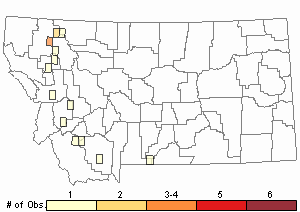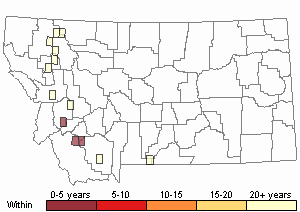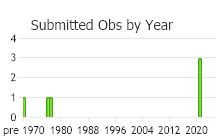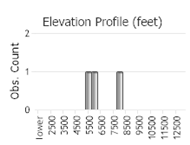View in other NatureServe Network Field Guides
NatureServe
Montana
Utah
Wyoming
Idaho
Wisconsin
British Columbia
South Carolina
Yukon
California
New York
Indian Feather Moss - Timmia megapolitana ssp. bavarica
Native Species
Global Rank:
G5T5?
State Rank:
S2S4
(see State Rank Reason below)
Agency Status
USFWS:
USFS:
BLM:
External Links
State Rank Reason (see State Rank above)
Timmia megapolitana subspecies bavarica is widespread in the western USA and most Canadian provinces (Brassard in Flora of North America 2007. Timmia megapolitana subspecies bavarica has been found in western and central Montana. At the subspecies level, population trends and threats have not been identified. Verified observations from revisits or new locations that bring forth population size, habitat condition, threat, and trend information is needed to refine the conservation status rank in Montana.
General Description
Plants: Acrocarpous (Vitt 1988). Growing in upright clumps, green or green with yellow tones above, brown below, with leaves above neither fragile nor deciduous (FNA 2007). Stems 1-6 cm tall (Lawton 1971); possessing a central stand; rhizoids numerous, black with reddish tones (FNA 2007).
Leaves: Appressed, overlapping to curled and twisted when dry, spreading a little when hydrated, lance-shaped FNA 2007), 5-10 mm in length (Lawton 1971); sheath base that envelops the stem transparent or sometimes with yellow tones, the non-clasping limb coarsely toothed above, the teeth more spaced and finer below, green; the change from sheath to limb sudden (FNA 2007); blade slightly narrower than the sheath (Lawton 1971); leaf tip acute; costa single, robust, extending to either just below or beyond the leaf tip (FNA 2007).
Leaf Cells: Costa smooth on the dorsal surface, seldom with papillae distally, mammillate on the ventral surface, in X-section (at mid-limb) with large dorsal and ventral cells, 2 stereid bands, and large guide cells; sheath laminal cells rectangular, wider and shorter near the transition to the limb, longer and more slender near the margins, with 1-6 papillae on the dorsal surface over the lumen or smooth; limb laminal cells low-mammillate on the ventral surface, smooth on the dorsal surface; cells at leaf attachment not easily breakable and transparent (FNA 2007).
Timmia megapolitana subsp. megapolitana: Present in Montana (FNA 2007).
Timmia megapolitana subsp. bavarica: Present in Montana (FNA 2007).
Range Comments
Timmia megapolitana (variety not determined): Known in Montana from Cascade, Flathead, Gallatin, Granite, Lake, Lewis and Clark, Missoula, Park, and Sanders Counties (Elliott 2016).
North American Range
Subspecies megapolitana: AK to NS, MT, SD and NE, MN s to AR and e to the coast (not in the Far South nor the Far Northeast) (FNA 2007).
Subspecies bavarica: AK to QC, ID and MT s to AZ and NM; Mexico (FNA 2007). Known in Montana from Carbon, Flathead, Gallatin, Lake, Madison, Missoula, Lewis and Clark, and Missoula Counties (Elliott 2016).
Observations in Montana Natural Heritage Program Database
Number of Observations: 17
(Click on the following maps and charts to see full sized version)
Map Help and Descriptions
Relative Density

Recency



 (Observations spanning multiple months or years are excluded from time charts)
(Observations spanning multiple months or years are excluded from time charts)
Habitat
Subspecies megapolitana: Calcareous habitats in damp humus, in wooded areas by large rivers, also becoming naturalized in places such as graveyards and lawns; mostly in temperate areas (FNA 2007). Elevation: To 6560 feet or above (Lawton 1971).
Subspecies bavarica: Habitats where nutrients collect, like at the bottom of bluffs or surrounding large rocks; mountainous areas of the Arctic (FNA 2007). Elevation: To 9840 feet or above (Lawton 1971).
Reproductive Characteristics
Monoicous. Perichaetial leaves more slender than the stem leaves. Perigonia each with 5-40 antheridia; perichaetia each with 1-6 archegonia (FNA 2007). Seta 10-30 mm tall (Lawton 1971), becoming red with age, sometimes 2 in a perichaetium (Crum & Anderson et al. 1981). Capsule generally 2.5-3 mm in length, wrinkled or with longitudinal furrows when dry; exostome teeth 16, yellow below, lighter in color or transparent above; endostome with 64 knobby, papillose cilia that have many pointed or star-shaped projections on the inside (FNA 2007).
Subspecies megapolitana: Fruit nearly always present. Leaf sheath with upper cells papillose. Calyptra frequently persisting in clasping the seta (just below capsule) after dropping away from the capsule (FNA 2007).
Subspecies bavarica: Fruit frequently present. Leaf sheath with upper cells smooth. Calyptra not remaining connected to the seta (FNA 2007).
Stewardship Responsibility
References
- Literature Cited AboveLegend:
 View Online Publication
View Online Publication Crum, H.A. and L.E. Anderson. 1981. Mosses of Eastern North America. 2 volumes. Columbia University Press, New York. 1328 pp.
Crum, H.A. and L.E. Anderson. 1981. Mosses of Eastern North America. 2 volumes. Columbia University Press, New York. 1328 pp. Elliott, J.C. and A.K. Pipp. 2018. A Checklist of Montana Mosses (1880-2018). Updated 3 January, 2020. Montana Natural Heritage Program, Helena, Montana. 73 pp.
Elliott, J.C. and A.K. Pipp. 2018. A Checklist of Montana Mosses (1880-2018). Updated 3 January, 2020. Montana Natural Heritage Program, Helena, Montana. 73 pp. Flora of North America Editorial Committee, eds. 2007. Flora of North America North of Mexico. Volume 27. Bryophytes: Mosses, Part 1. Oxford University Press, Inc., NY. xxi + 713 pp.
Flora of North America Editorial Committee, eds. 2007. Flora of North America North of Mexico. Volume 27. Bryophytes: Mosses, Part 1. Oxford University Press, Inc., NY. xxi + 713 pp. Lawton, E. 1971. Moss Flora of the Pacific Northwest. Hattori Botanical Laboratory. Japan: Yamabuki-cho, Shinjuku-ku, Tokyo. 362 pages plus appendices.
Lawton, E. 1971. Moss Flora of the Pacific Northwest. Hattori Botanical Laboratory. Japan: Yamabuki-cho, Shinjuku-ku, Tokyo. 362 pages plus appendices. Vitt, D. J. Marsh, and R. Bovey. 1988. Mosses, Lichens & Ferns of Northwest North America. Seattle, WA: University of Washington Press. 296 p.
Vitt, D. J. Marsh, and R. Bovey. 1988. Mosses, Lichens & Ferns of Northwest North America. Seattle, WA: University of Washington Press. 296 p.
- Additional ReferencesLegend:
 View Online Publication
View Online Publication
Do you know of a citation we're missing? Elliot, J. C. 1993. Second checklist of Montana mosses. Unpublished report. U.S. Forest Service, Region 1. Missoula, MT. 45 pp.
Elliot, J. C. 1993. Second checklist of Montana mosses. Unpublished report. U.S. Forest Service, Region 1. Missoula, MT. 45 pp. Lawton, E. 1971. Keys for the Identification of the Mosses on the Pacific Northwest. Reprinted from 'Moss Flora of the Pacific Northwest'. Published as Supplement No. 2 of the Journal of the Hattori Botanical Laboratory. Nichinan, Miyazaki, Japan. 66 pp.
Lawton, E. 1971. Keys for the Identification of the Mosses on the Pacific Northwest. Reprinted from 'Moss Flora of the Pacific Northwest'. Published as Supplement No. 2 of the Journal of the Hattori Botanical Laboratory. Nichinan, Miyazaki, Japan. 66 pp.
- Web Search Engines for Articles on "Indian Feather Moss"





